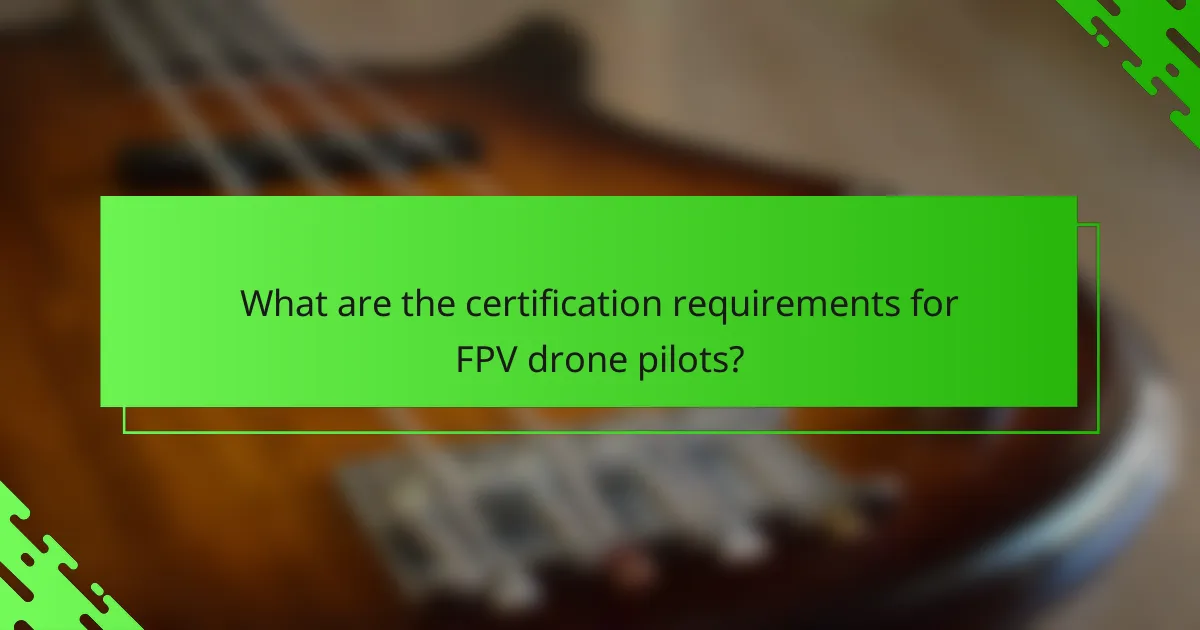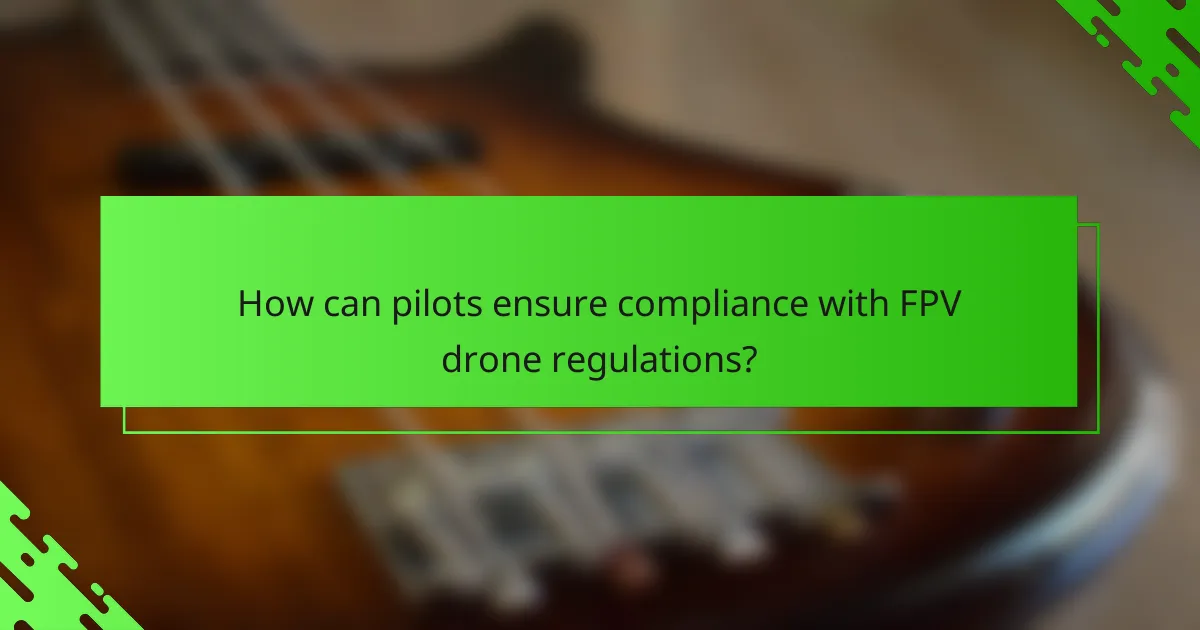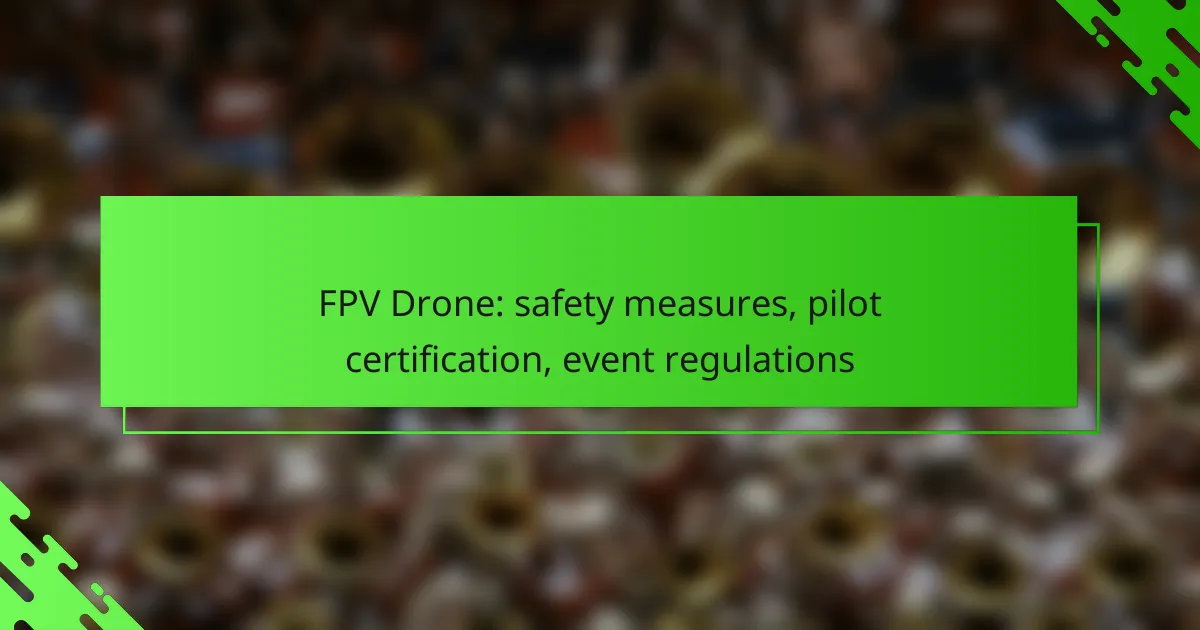FPV drone operation requires adherence to essential safety measures, including pre-flight checks and regular equipment maintenance, to ensure compliance with regulations. Pilots must also obtain necessary certifications, such as the FAA Part 107 in the U.S., to operate legally and safely. Additionally, FPV drone events are regulated by the FAA and local authorities, encompassing permits, insurance, and local ordinance compliance.

What safety measures should FPV drone pilots follow?
FPV drone pilots should adhere to several safety measures to ensure safe operation and compliance with regulations. Key practices include conducting thorough pre-flight checks, following emergency protocols, managing battery life effectively, considering weather conditions, and maintaining equipment regularly.
Pre-flight checklists
Before flying, pilots should complete a pre-flight checklist to verify that all systems are functioning correctly. This includes checking the drone’s battery level, ensuring that the camera and video transmission are operational, and inspecting the propellers for damage.
A typical checklist might include items such as verifying GPS signal strength, confirming that all firmware is up to date, and ensuring that the remote control is paired with the drone. Pilots should also check for any local airspace restrictions that may affect their flight.
Emergency protocols
Having emergency protocols in place is crucial for FPV drone pilots. These protocols should outline steps to take in case of loss of signal, low battery warnings, or equipment failure. Pilots should practice these scenarios to ensure they can react quickly and effectively during an actual emergency.
Common emergency actions include initiating a return-to-home function, performing a controlled landing, or switching to manual control if the drone becomes unresponsive. Pilots should also inform nearby people of their flight operations to prevent accidents.
Battery management
Proper battery management is essential for safe FPV drone operation. Pilots should monitor battery levels closely and avoid flying when the battery is below a certain threshold, typically around 20-30%. This helps prevent unexpected power loss during flight.
Additionally, pilots should follow guidelines for charging and storing batteries, such as using a dedicated LiPo charger and avoiding extreme temperatures. Regularly inspecting batteries for swelling or damage can prevent potential hazards.
Weather considerations
Weather conditions significantly impact drone safety. Pilots should avoid flying in high winds, rain, or low visibility, as these factors can affect control and increase the risk of crashes. Checking local weather forecasts before a flight is essential.
It’s advisable to fly in clear, calm conditions whenever possible. If weather conditions change unexpectedly during a flight, pilots should be prepared to land the drone safely and quickly.
Equipment maintenance
Regular equipment maintenance is vital for ensuring the safe operation of FPV drones. Pilots should routinely inspect their drones for wear and tear, focusing on critical components like motors, propellers, and the frame. Any damaged parts should be replaced before the next flight.
Additionally, keeping software and firmware updated can enhance performance and safety. Pilots should also clean their equipment after each flight to remove debris and prevent malfunctions.

What are the certification requirements for FPV drone pilots?
FPV drone pilots must meet specific certification requirements to operate legally and safely. These typically include obtaining the FAA Part 107 certification in the United States, completing relevant training programs, and passing testing procedures to ensure proficiency and knowledge of regulations.
FAA Part 107 certification
The FAA Part 107 certification is essential for commercial drone pilots in the U.S. It requires pilots to pass a knowledge test covering airspace regulations, weather, and drone operations. This certification allows pilots to fly drones for commercial purposes, provided they adhere to the outlined operational limitations.
To obtain this certification, pilots must be at least 16 years old and pass a written exam at an FAA-approved testing center. The exam typically consists of 60 multiple-choice questions, and a passing score is usually around 70 percent.
Training programs
Various training programs are available for aspiring FPV drone pilots, ranging from online courses to in-person workshops. These programs often cover essential topics such as drone mechanics, flight safety, and regulatory compliance. Many programs also include hands-on flight training to build practical skills.
Choosing a reputable training program can significantly enhance a pilot’s understanding and readiness for the FAA Part 107 exam. Some programs even offer practice tests and study materials to help candidates prepare effectively.
Testing procedures
The testing procedures for FPV drone pilot certification typically involve a written exam administered at designated testing centers. Candidates must register in advance and pay a fee, which can vary based on the testing location. The exam duration is usually around two hours.
After passing the written test, pilots receive a temporary certificate, which is valid for two years. To maintain certification, pilots must complete a recurrent training course or retake the exam before the expiration date.

What regulations govern FPV drone events in the United States?
FPV drone events in the United States are primarily regulated by the Federal Aviation Administration (FAA) and local authorities. These regulations cover aspects such as event permits, insurance requirements, and adherence to local ordinances.
Event permits
To host an FPV drone event, organizers typically need to obtain a special event permit from local authorities. This process may involve submitting an application that outlines the event details, including location, dates, and expected attendance.
In some cases, the FAA may also require a waiver for operations that do not comply with standard regulations, especially if flying in controlled airspace. It’s advisable to check both local and federal requirements well in advance of the event.
Insurance requirements
Insurance is a critical aspect of hosting FPV drone events. Organizers should consider obtaining liability insurance to cover potential damages or injuries that may occur during the event. Policies can vary widely, but coverage typically ranges from $1 million to $5 million.
Some venues may require proof of insurance before granting permission for the event, so it’s essential to secure this documentation early in the planning process.
Local ordinances
Local ordinances can significantly impact FPV drone events, as different states and municipalities may have specific rules governing drone use. These can include restrictions on flying in certain areas, noise regulations, and safety protocols.
Organizers should research local laws and consult with local authorities to ensure compliance. Failing to adhere to these ordinances can result in fines or event cancellations.

How can pilots ensure compliance with FPV drone regulations?
Pilots can ensure compliance with FPV drone regulations by staying informed about current laws, obtaining necessary certifications, and adhering to event-specific guidelines. Understanding these regulations is crucial for safe and responsible flying.
Regular updates on regulations
FPV drone regulations can change frequently, so pilots must regularly check for updates from relevant authorities, such as the Federal Aviation Administration (FAA) in the United States or the European Union Aviation Safety Agency (EASA) in Europe. Subscribing to newsletters or following official social media accounts can help keep pilots informed.
Additionally, pilots should familiarize themselves with local laws that may affect their flying, such as restrictions on flying near airports or populated areas. Engaging with local flying communities can also provide insights into recent regulatory changes.
Joining FPV organizations
Joining FPV organizations can provide pilots with valuable resources and support for navigating regulations. These organizations often offer training, certification programs, and access to legal advice regarding compliance with drone laws.
Membership in such groups can also facilitate networking with other pilots, which can enhance knowledge sharing about best practices and safety measures. Examples of organizations include the Academy of Model Aeronautics (AMA) in the U.S. and the British Drone Association (BDA) in the UK.

What are the best practices for FPV drone safety in urban areas?
To ensure safety while flying FPV drones in urban areas, pilots should prioritize awareness of their surroundings, adhere to local regulations, and maintain proper equipment. These practices help minimize risks to people and property while maximizing the enjoyment of drone flying.
Flight zone awareness
Flight zone awareness involves understanding the specific areas where drone operation is permitted and the potential hazards present. Pilots should familiarize themselves with local laws regarding drone use, including no-fly zones, which often include airports, schools, and densely populated regions.
Before flying, assess the environment for obstacles such as buildings, power lines, and other aircraft. Always maintain a safe distance from these hazards to avoid collisions. A good rule of thumb is to keep the drone at least 30 meters away from people and structures.
Utilizing apps or tools that provide real-time information on airspace restrictions can enhance flight zone awareness. These resources help pilots plan their flights effectively and ensure compliance with regulations.
